SENSE. Newsletter 2025

a message from the consortium
Dear Readers,
Over the past three years, SENSE. has grown from an idea into a living approach, shaped through collaboration with our partners, SENSE Labs, and hundreds of stakeholders across Europe. Together with teachers, students, artists, museum professionals, and policymakers, we have explored what it means to make STEAM education more embodied, learner-led, and socially inclusive. The result is an approach that is practical, inspiring, tested throughout Europe and ready to be used in many different settings.
A major outcome of this journey are the SENSE Roadmap and Digital Hub, tools designed to guide, inspire, and connect. They enable educators, institutions, and communities to explore the SENSE. approach to STEAM education at their own settings, discover activities, and adapt methods to their needs. Additionally, the hub provides a space for sharing experiences and building new connections.
We warmly invite you to get involved: visit the Digital Hub, explore the Learning Companion, connect with one of the LABs and try out activities in your own setting. Let’s continue to expand the reach and impact of this approach, ensuring that science education remains creative, inclusive, and future-proof.
Happy reading!
The SENSE. team
The Future of STEAM Education: The SENSE.STEAM Roadmap & Digital Hub
The SENSE project is building tools to make STEAM education more embodied, learner-led, and future-proof. At the heart of this effort are two key elements: the SENSE Roadmap and the SENSE Digital Hub. The Roadmap provides the vision, and the Digital Hub provides the means. Together, they enable educators and stakeholders to not only understand the SENSE approach but also to apply it in practice.
The SENSE Roadmap: A Modular Guide for Change
The SENSE Roadmap: A Modular Guide for Change
Over the past three years, SENSE. has grown from an idea into a living approach, shaped through collaboration with our partners, SENSE Labs, and hundreds of stakeholders across Europe. Together with teachers, students, artists, museum professionals, and policymakers, we have explored what it means to make STEAM education more embodied, learner-led, and socially inclusive. The result is an approach that is practical, inspiring, tested throughout Europe and ready to be used in many different settings.
A major outcome of this journey is the SENSE Roadmap and Digital Hub, tools designed to guide, inspire, and connect. They enable educators, institutions, and communities to explore the SENSE. approach to STEAM education at their own settings, discover activities, and adapt methods to their needs. Additionally, the hub provides a space for sharing experiences and building new connections.
We warmly invite you to get involved: visit the Digital Hub, explore the Learning Companion, connect with one of the LABs and try out activities in your own setting. Let’s continue to expand the reach and impact of this approach, ensuring that science education remains creative, inclusive, and future-proof.
The SENSE Roadmap is designed to guide the uptake of STEAM education in schools, communities, and beyond. Unlike traditional roadmaps that follow a single path, it uses a modular and partly non-linear structure. This makes it possible for stakeholders, from teachers and students to policymakers and families, to choose and combine elements according to their own needs and contexts.
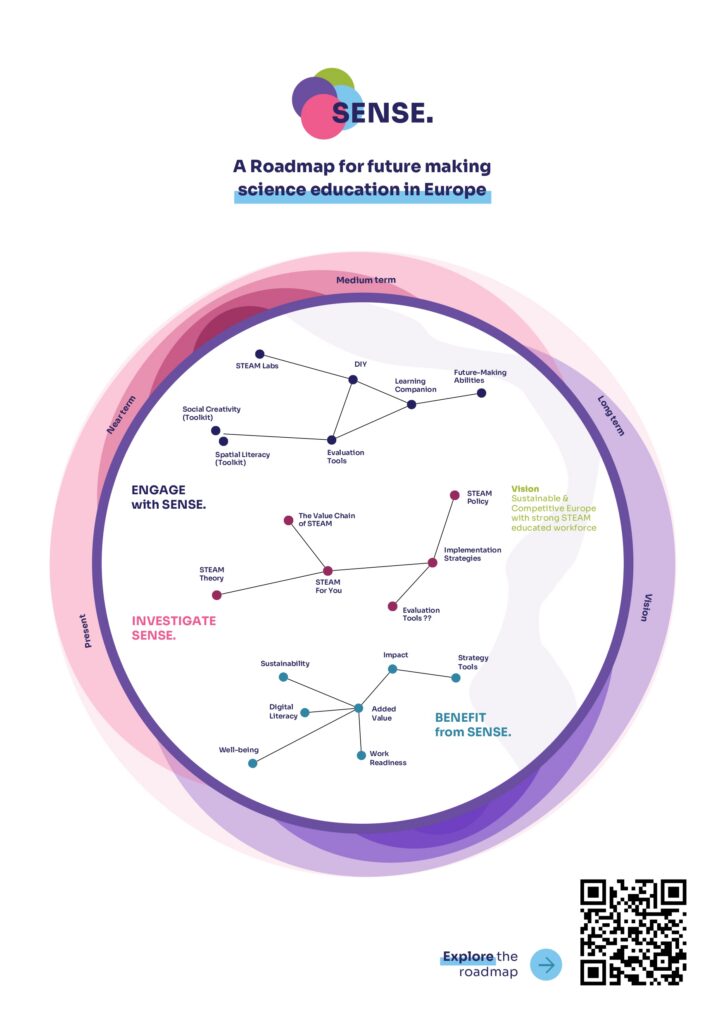
What does the roadmap offer?
- A clear overview of existing STEAM practices and how they connect to the SENSE approach.
- Evidence of the relevance and societal value of STEAM in tackling today’s grand challenges, from climate change to digitalization.
- A distinctive educational model and pedagogy, grounded in embodied learning, creativity, and collaboration.
- Practical tools, including a Learning Companion and the SENSE Digital Hub, to support educators in bridging theory and practice.
- Spaces for community engagement through the STEAM Academy and Labs, fostering peer learning and partnerships.
The roadmap also highlights the transformative dimensions of SENSE.STEAM inquiry: noticing deeply, embodied knowing, questioning, connecting, empathizing, creating meaning, and reflecting. These moves help overcome the limitations of traditional STEM by making learning more inclusive, engaging, and future oriented.
You can checkout the Roadmap here.
The SENSE Digital Hub: A Living Platform
To make the roadmap accessible, engaging, and sustainable, it is embedded in the SENSE Digital Hub. This online platform acts as a gateway to SENSE resources, designed for exploration, co-creation, and long-term use.
The Hub features three layers of engagement:
- Benefit from SENSE (Why): Showcasing the impact of STEAM on well-being, sustainability, digital literacy, and work-readiness. Here, stakeholders can discover why STEAM matters for their context – from schools and families to companies, museums, and academia.
- Investigate SENSE (What): Offering insights into the educational model behind SENSE, with background theory, case studies, and examples of how embodied and interdisciplinary learning can be applied.
- Engage with SENSE (How): A hands-on space with practical tools, such as the Learning Companion with 22 activities, lived experiences by actual STEAM Labs, evaluation methods, and creative toolkits for exploring space and ensuring inclusivity.
With its mix of fun, flexibility, and functionality, the Digital Hub supports both individual exploration and collective action. Whether you are a teacher designing a new learning activity, a policymaker exploring strategies, or a student curious about STEAM futures, the Digital Hub is your entry point to meaningful engagement.
We invite you to explore the digital hub yourself here.
SENSE.STEAM in Action: Early Adopters and Real-World Implementation
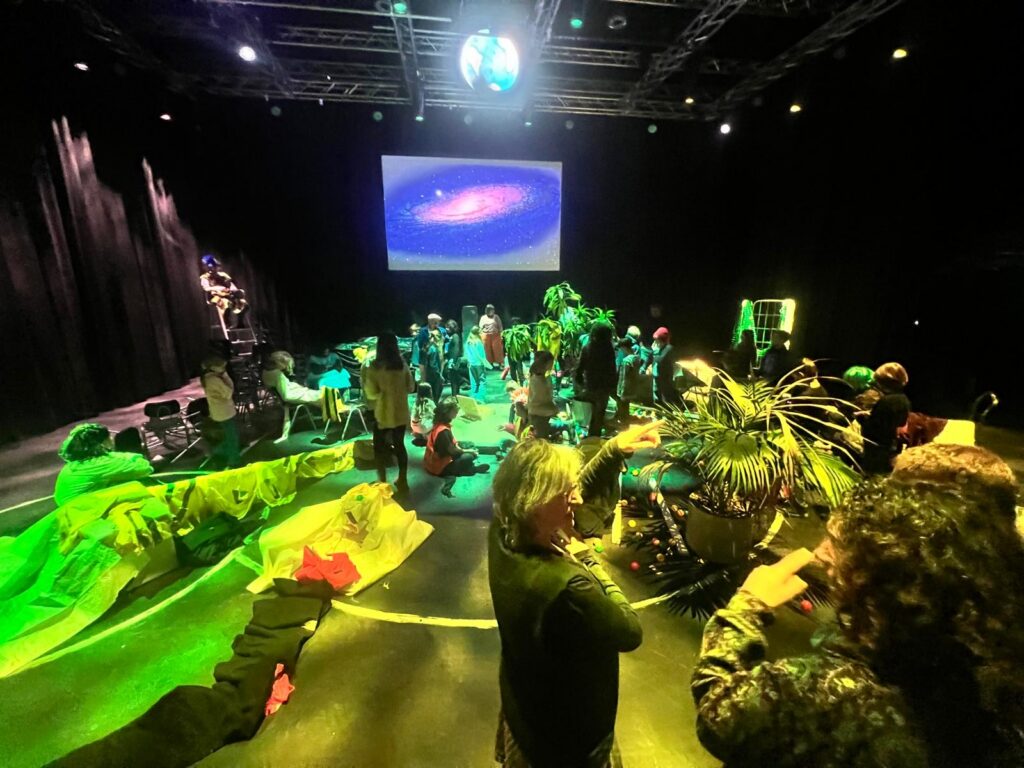

Between 2023 and 2025, nine SENSE.STEAM Labs across Europe piloted the methodology in diverse settings with over 500 Early Adopters, from classrooms and universities to museums, theatres, and community spaces.
The pilots demonstrated that the SENSE. approach is adaptable and scalable. Whether in a classroom, a museum, or a civic space, participants reported increased creativity, collaboration, and curiosity. Importantly, the methodology proved to be:
- Inclusive: creating opportunities for underrepresented groups, especially women and girls, to engage in STEAM.
- Flexible: easily tailored to different stakeholder needs and contexts.
- Future-ready: aligning with societal challenges such as the Green Deal, digitalisation, and work-readiness.
Quote 1: “The selection of materials allowed us to freely create and imagine what to do…”
Teacher student, HVL – about the method “House of a fairy”
Quote 2: “It is definitely a motivating activity, and inspired me for more team-based and practical tools in education!”
Social worker, ODYSSEA– about the method “Extraterrestrial life”
Monza – CREDA Environmental Centre
At the CREDA environmental centre in Monza, Italy, the SENSE approach was woven into activities on ecology and sustainability. Teachers and students worked hands-on with soil and water explorations, connecting scientific observation with sensory experiences. This allowed participants to understand environmental phenomena in a new way — not only through data, but also through touch, smell, and embodied interaction. The activities inspired educators to integrate more experiential methods into environmental education.
Bergen – VilVite Science Centre
At the VilVite science centre in Bergen, Norway, early adopters experimented with phenomenon-based STEAM learning. Using the SENSE Learning Companion, student teachers designed and tested activities that merged natural sciences with artful expression. For example, they developed projects around light, sound, and movement that invited learners to both experiment scientifically and create artistically, showing how STEAM can break down silos between disciplines.
Bochum – Theatre of Research
The Theatre of Research in Bochum, Germany, demonstrated the power of SENSE in creative spaces. Here, artists, researchers, teachers, and students co-created performances and learning activities that blurred the lines between art, science, and play. These experiments highlighted how embodied and sensory approaches can spark curiosity and imagination, while still grounding learning in rigorous scientific inquiry.
These concrete implementations show that the SENSE approach is not just theoretical, but adaptable to multiple contexts: from ecology and sustainability, to interactive science learning, to artistic performance. Across all cases, participants reported increased engagement, creativity, and inclusion — proving that STEAM can truly be embodied, learner-led, and socially inclusive.
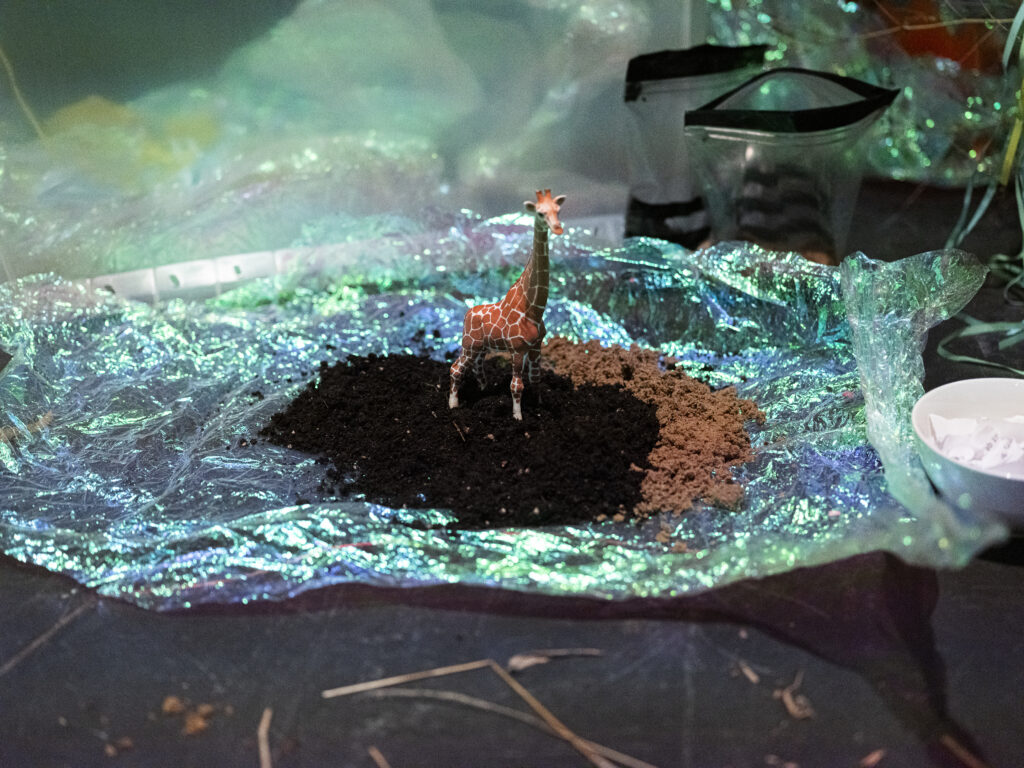
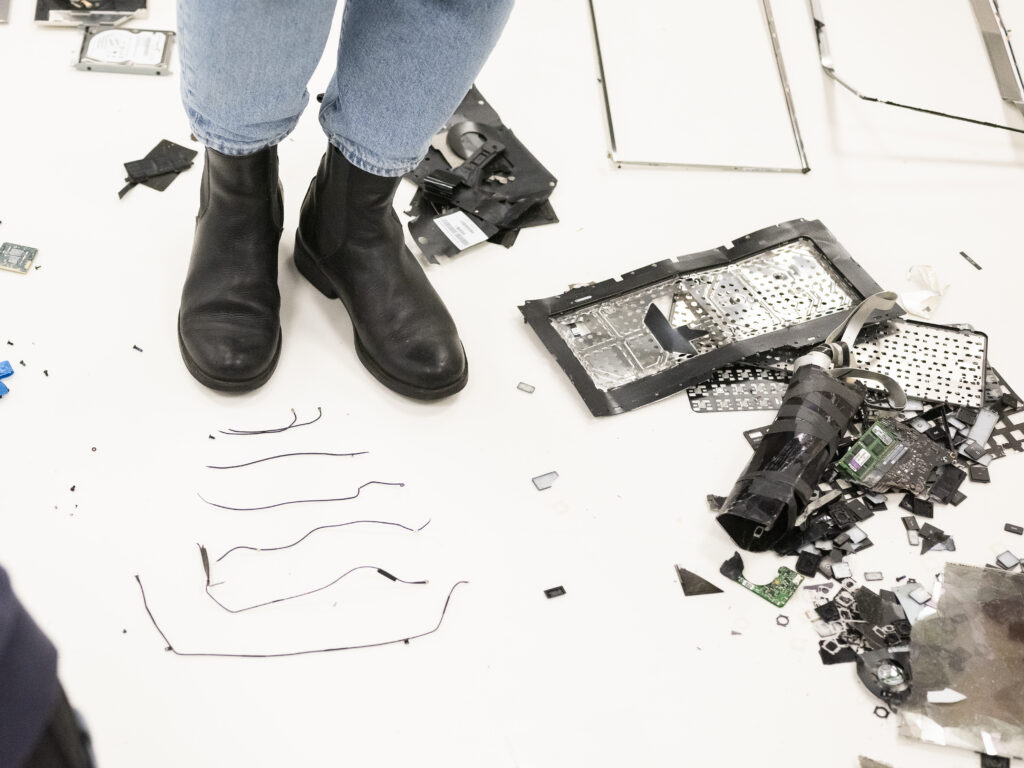
Policy Recommendations: STEAM based future-making education
As the SENSE. project reaches its final stage, we are proud to present a set of policy recommendations that can guide Europe toward a more inclusive, creative, and future-ready education system. Based on three years of collaboration, experimentation, and research in 13 STEAM Labs and with stakeholders across Europe, these recommendations are rooted in practice and tailored to the needs of learners, educators, and policymakers.
- Workforce skills: Integrate STEAM into skills training to strengthen observation, creativity, and problem-solving across all sectors.
- Teacher education: Embed STEAM principles into teacher training and re-training programmes, ensuring both new and in-service teachers are prepared to foster innovative, learner-centred classrooms.
- Curriculum reform: Revise national curricula in STEM subjects to integrate interdisciplinary and inclusive STEAM approaches.
- Open schooling: Remove barriers that limit collaboration between schools, businesses, arts, and civil society to create richer learning environments.
- Educational spaces: Redesign schools and learning spaces to support inclusive, participatory learning and social interaction.
- Higher education & NEB: Promote uptake of the New European Bauhaus values (sustainability, inclusivity, beauty) in vocational and tertiary education.
- Life-long learning: Support informal and non-formal STEAM learning opportunities beyond school years.
- STEAM networks: Strengthen European networks to scale impact and sustain collaboration across countries.
These recommendations go beyond classrooms. They are about creating a scientifically literate, socially inclusive, and resilient Europe, where learners of all ages, especially women and underrepresented groups, can thrive. By embedding STEAM principles into education policies and systems, we can better equip society to face challenges such as the Green Deal, digital transformation, health, and future work-readiness.
Impact report & Romanian case study
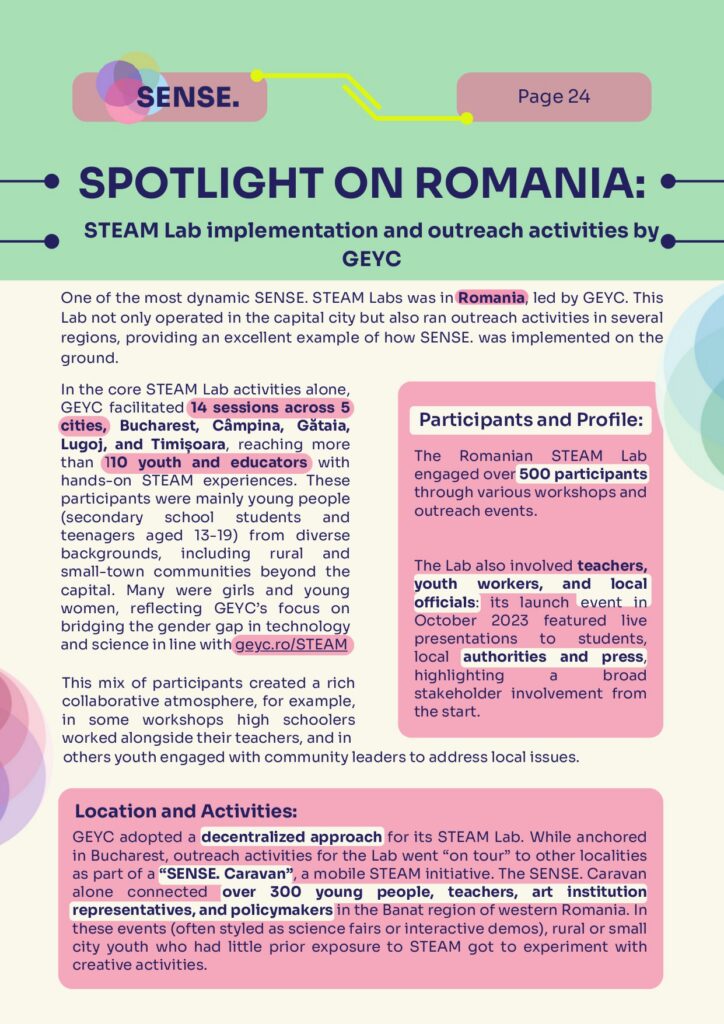
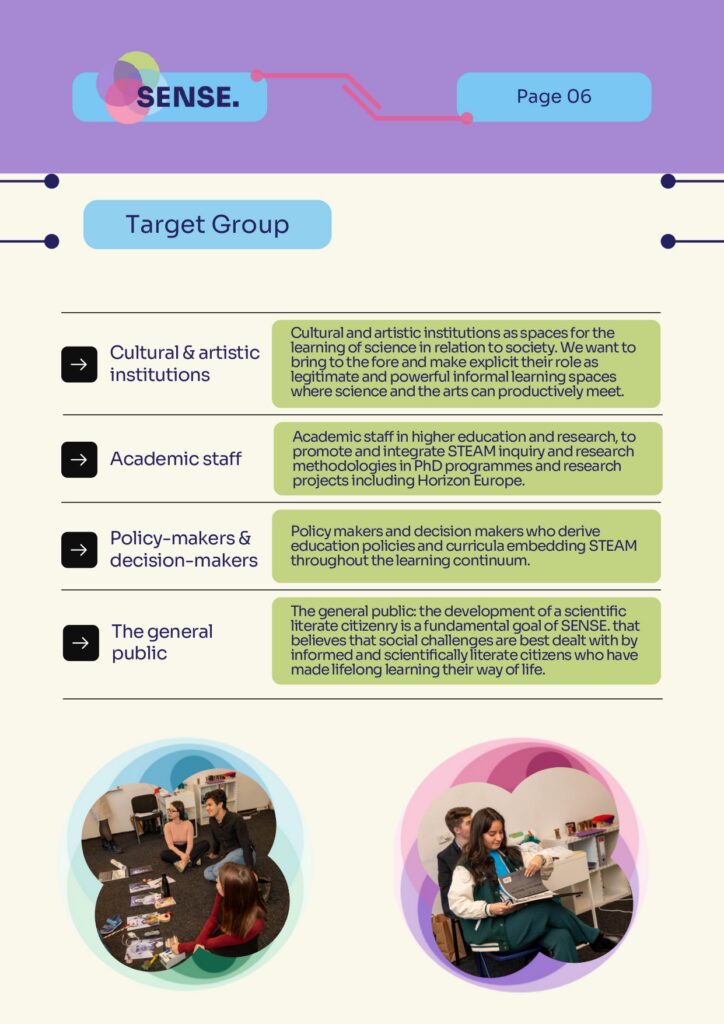
Across three years and seven work packages, the consortium co-created an innovative approach, tested it in 13 STEAM Labs across Europe directly engaging over 4.000 participants and reaching 100.000 in total. Outputs include sustainability efforts and products such as learning activities, two toolkits, and policy recommendations, all distributed via the SENSE. Digital Hub.
The project demonstrated adaptability to contexts and beneficiaries with promising evaluation results and feedback. Beyond direct outcomes, SENSE. shows potential for institutional and structural change toward more inclusive, innovative, interdisciplinary, and sustainable education in Europe.
This impact report is for the public and for current and future stakeholders of STEAM education: educators, curriculum designers, decision and policy makers, and anyone interested in teaching and learning. It features the impact at the consortium level and then dives into the Romanian case study of GEYC’s activities, focusing on the Labs and outreach efforts.
